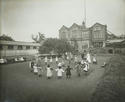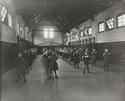 In this period a clearer pattern of school provision emerged. In 1918 the city's five School Boards were amalgamated into one Glasgow Education Authority which became the largest education authority in Britain. In 1929 the functions of the Glasgow Education Authority were transferred to the Corporation which managed schools through its Education Committee. By 1955 it managed 177 primary and seventy-nine secondary schools alongside a range of "special" schools such as those for the deaf.
In this period a clearer pattern of school provision emerged. In 1918 the city's five School Boards were amalgamated into one Glasgow Education Authority which became the largest education authority in Britain. In 1929 the functions of the Glasgow Education Authority were transferred to the Corporation which managed schools through its Education Committee. By 1955 it managed 177 primary and seventy-nine secondary schools alongside a range of "special" schools such as those for the deaf.
 The city's schools had to cope with the disruption caused by the World Wars and legislative changes such as the raising of the school leaving age from 14 to 15 in 1947. The predominant influence on schools was the "11+" exam that determined entry of pupils into either junior secondary (offering three year courses) or senior secondary schools (offering five year courses). Schools such as Hyndland became well known senior secondary schools with John Street and Adelphi Street among Glasgow's respected junior secondaries. School provision had, however, to take account of the religious divide with the creation of denominational (Roman Catholic) and non-denominational schools.
The city's schools had to cope with the disruption caused by the World Wars and legislative changes such as the raising of the school leaving age from 14 to 15 in 1947. The predominant influence on schools was the "11+" exam that determined entry of pupils into either junior secondary (offering three year courses) or senior secondary schools (offering five year courses). Schools such as Hyndland became well known senior secondary schools with John Street and Adelphi Street among Glasgow's respected junior secondaries. School provision had, however, to take account of the religious divide with the creation of denominational (Roman Catholic) and non-denominational schools.
 Most of the schools under the control of the Education Committee provided education free of charge, but a number of the city's schools charged fees. These schools included Allan Glen's, The Boys' and Girls' High Schools, Hillhead High and Hutchesons' Boys' and Girls' Grammar Schools. These schools existed alongside fully independent schools such as Laurel Bank for girls and Glasgow Academy.
Most of the schools under the control of the Education Committee provided education free of charge, but a number of the city's schools charged fees. These schools included Allan Glen's, The Boys' and Girls' High Schools, Hillhead High and Hutchesons' Boys' and Girls' Grammar Schools. These schools existed alongside fully independent schools such as Laurel Bank for girls and Glasgow Academy.